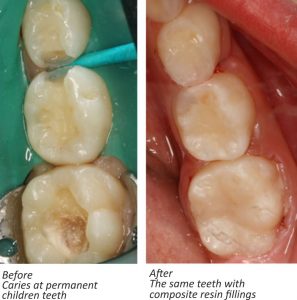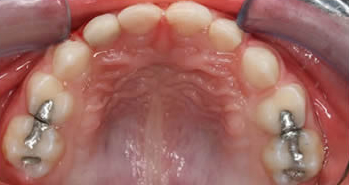Therapies
Fillings
When a tooth has a cavity the treatment of choice is usually the placement of a filling, unless the cavity is too large or too deep into the nerve. In such cases and especially if the tooth had a root canal treatment a crown is considered necessary.
The material of choice we use nowadays is the mainly white in color and is composed of composite resin material (see image below). The composite resin is a strong and durable material but it is technique sensitive.

The Amalgam filling (silver filling) is still being used nowadays but is reserved for cases with very large or subgingival fillings on permanent posterior teeth. The reason for its’ use on such teeth is due to its’ good reaction in humid conditions and due to the properties that the amalgam has, which stays on the teeth for a much longer period of time.
In concern of toxicity, this is because Amalgam contains mercury which is toxic to the environment. When the excess from the filling gets drained, it ends up into the soil or in the water and thus leads to contamination. This was the main reason that Amalgam began to slowly get withdrawn from the Dental practice. There is still no suitable proof that Amalgam is toxic in the mouth since Mercury is incorporated into the filling and not in free form such as it is in the form of waste.

Stainless steel crowns
When a posterior primary tooth has a very large cavity then a stainless steel crown is placed instead of a filling. Also, a stainless steel crown may be placed if the tooth has multiple small cavities, or when a root canal or pulpotomy is done on the tooth.
The stainless steel crown is made of pure stainless steel and comes in several sizes. After the preparation of the tooth we choose the right size of crown which we crimp and contour to the correct form and then we cement it on the tooth.
This stainless steel crown functions just as well as a regular tooth and since it is cemented on the tooth, the crown will fall off together with the tooth when the normal exfoliation time comes. The greatest advantage of the stainless steel crown is that the tooth is no longer in danger of being cavitated since the crown covers the whole surface of the tooth.
Stainless steel crowns are valuable in cases where the child has a high risk to cavities since it protects the tooth from repeated fillings and the consequences that follow. Also the stainless steel crown is necessary when the tooth undergoes root canal treatment since it protects it from fractures due to dehydration.

Pulpotomy
In primary teeth when a cavity (black area in the picture) is next to the nerve (red area in the picture) of the tooth then a pulpotomy may be necessary.
In a pulpotomy procedure the superficial part of the nerve (middle tooth in the picture) is removed due to its close proximity with the cavity, in order to eliminate any possible infection of the top part of the nerve and stop its spread in the root nerve. By doing so, we can usually maintain the tooth in the mouth in a healthy condition for few years till its’ normal exfoliation time. The success rate of the pulpotomies are 75% and a follow up is needed in order to confirm their success.
When a tooth receives a pulpotomy treatment, it becomes sensitive and a stainless steel crown is needed.
Root canal treatment
When the cavity is too deep and causes inflammation to the whole nerve of the tooth then a root canal treatment may be necessary. In a root canal procedure, the whole nerve is removed from the tooth and an antibacterial medicament is placed in the canals.
If your child has spontaneous pain (pain that appears without any stimuli) then a root canal treatment may be necessary.
However, if your child’s primary tooth is heavily inflected and has an abscess formation and facial swelling then an extraction maybe necessary since a root canal treatment is not very successful in these cases. In permanent teeth, a root canal treatment can be successfully done no matter how heavily infected the tooth is.
Do not worry if a primary tooth needs a root canal treatment! The permanent successor tooth has its’ very own nerve, therefore the removal of the nerve of the primary tooth will not affect the nerve of the permanent tooth at all!
Extractions
If a primary tooth is badly damaged by a cavity and cannot be restored, or if it is heavily infected with abscess formation or swelling of the face of the patient, then an extraction may be necessary.
Infected primary teeth must not be retained in the mouth because they may damage the permanent successor tooth.
If an extraction of a primary tooth is necessary and it is still not time of the permanent tooth to erupt then a space maintainer may be placed to hold the space till the eruption of the permanent tooth.
